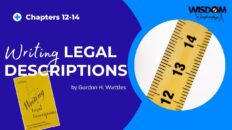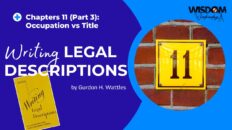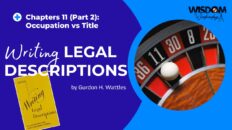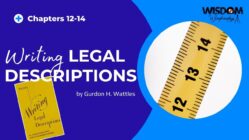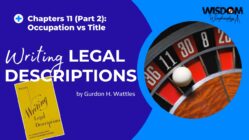Wisdom Wednesdays for the land surveying profession is a bi-weekly roundtable discussion to go over a chapter at a time from our “Surveying Bibles.” The goal is for everyone to read a chapter of a book and then have a round table discussion about that chapter. The current book being discussed is Writing Legal Descriptions by Gurdon H. Wattles.
Meeting summary for Wisdom Wednesdays for the Land Surveying Profession – “Book Club” (12/14/2023) – From Zoom
Quick recap
The team had a wide-ranging discussion about office decorations, personal experiences, and the holiday season. James, who joined late due to health issues, expressed his hope for differing opinions and shared a diagram he hoped to present. The conversation then shifted to a project, but no specific decisions or action items were discussed. The team also discussed a land survey issue involving property rights and the need for fieldwork prior to drafting a deed. They also discussed the challenges associated with legal descriptions of properties and the importance of accuracy. The team also discussed the complexities of deciphering old property deeds and the principles of property boundary surveying. They concluded the meeting by scheduling their next session on January 17th and 31st.
Summary
Property Deeds and Land Surveying Discussion
James led a discussion on the interpretation of a CAD sheet and work-up related to a property’s deeds. They explained the importance of distinguishing between a general warranty date and a quick claim date, and the complexity of the property’s boundaries, specifically the south line of Lot 18. James proposed the need for a land surveying evaluation and confirmed the decision to follow the intersection of the two lines until further information is available. The team also discussed a land survey issue involving property rights and the need for fieldwork prior to drafting a deed. Trent Keenan emphasized the potential margin of error in measurements, while Joe and David stressed the need to establish Lot 18 and 17 before proceeding. Trent Keenan raised a question about whether the lots were actually simultaneously conveyed, and James emphasized the need for decisions based on what the original parties intended. The team also discussed the complexity of track B and the need for a deed to define a particular piece of property.
Property Description Challenges Discussed
Trent Williams, Jerry, and Brad discussed the challenges associated with legal descriptions of properties. Jerry pointed out that many descriptions are not clear enough, leading to difficulties in interpretation later on. They emphasized the importance of writing descriptions that can be clearly identified. Trent Williams presented an example of a poorly written property description that they were tasked with correcting. The discussion also touched upon the role of surveys in defining property boundaries and the issues that can arise when a survey is not involved. The group agreed that it’s crucial to ensure the accuracy of property descriptions to avoid errors and confusion in the future.
Property Description Challenges Discussed
Trent Williams discussed the challenges of creating a description for a property that had been divided due to a misplaced deed recording. Jerry raised concerns about the use of incorrect symbols in descriptions and how it could lead to interpretation issues. Jon clarified that the descriptions are typically for tax purposes only and are not intended for legal use. Trent agreed, explaining that the description in question was a tax description and not a legal one. The team also discussed the financial implications of such jobs and the challenges faced in different states regarding property description.
Deciphering Old Property Deeds Orientation
James discussed the complexities of deciphering old property deeds, particularly in relation to identifying the orientation and dimensions of a track day. They emphasized the importance of providing shape, size, and orientation, regardless of the style of description used. James also noted ambiguities in the language of the deeds which made it difficult to identify the boundaries of Lot 17. They proposed a solution to determine the track’s orientation by using the westernmost point of Lot 17 and applying a 50-foot wide script across it. James believed that this method could be universally applied to various tracks and would help define specific properties.
Property Boundary Surveying Principles Debated
James and Trent Williams discussed the principles of property boundary surveying and its reliance on fieldwork and evidence. They debated the implications of property owners’ actions in establishing boundaries, with James suggesting that court decisions may consider the intent of the parties. They also discussed the complication of overlapping property lines, with James noting that the owner of the original property might retain ownership of the overlap, even if the property is sold and resold. James highlighted the potential conflict between the principles of surveying and the principles of law in such situations.
Legal Principles in Land Surveying
James emphasized the importance of legal principles in land surveying, highlighting the necessity of obtaining fiscal and record evidence. The team, including Trent Williams, Trent Keenan, Bradley, Jerry, and David, engaged in a detailed discussion about a property line, interpreting the legal description and its corresponding dimensions. They considered the significance of different distances and angles and debated the nature of the “Arsenault line”. The team concluded that the westerly 50 feet was to be interpreted as parallel with the westerly line of Lot 17, as long as it was within a 22.5-degree angle. They decided to continue the discussion in another session.
Property Boundary Definition Challenges
David, Trent Keenan, Jerry, Trent Williams, and James had a discussion about the challenges of defining property boundaries, especially in instances where the boundaries are curved. They stressed the significance of professional opinion in such matters and the need to resolve any ambiguities in subsequent legal descriptions or surveys. The group also debated the importance of specific words, like “west” and “westerly,” when describing property lines. Trent Williams highlighted the potential issues that could arise from using imprecise descriptions in deeds, while Trent emphasized the importance of clear land boundaries in property descriptions.
Surveying’s Importance and Challenges
Trent Williams highlighted the importance of merging theoretical knowledge with practical experience in surveying, noting the challenges young surveyors face in connecting the two. They underscored the necessity of mentorship and bridging the gap between field and office experiences. Trent also discussed the potential impact of changing certain line dimensions, such as the 50 and 51 degree lines, with the suggestion of making the 50 degree line 51 degrees. The meeting also touched on the variability of test results.
Land Surveying Legal Challenges Discussed
James and Trent Keenan discussed the challenges and legal complexities of land surveying. They emphasized the importance of understanding rules of evidence and the role of lawyers in land disputes. James shared their experience working with professionals like John Stall, who often served as consultants for lawyers in high-litigation cases. Trent Williams agreed with James’s perspective, citing their own experiences. Towards the end, they decided to schedule their next meeting on January 17th and 31st.
AI-generated content may be inaccurate or misleading. Always check for accuracy.



